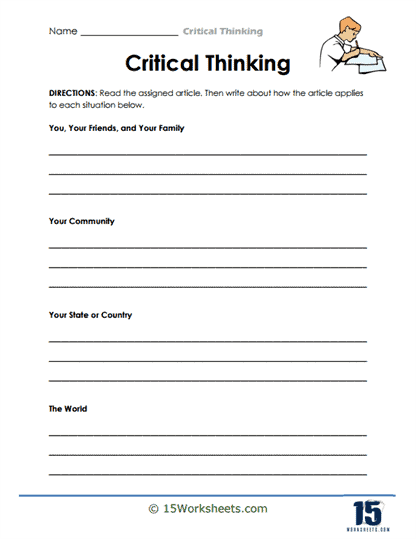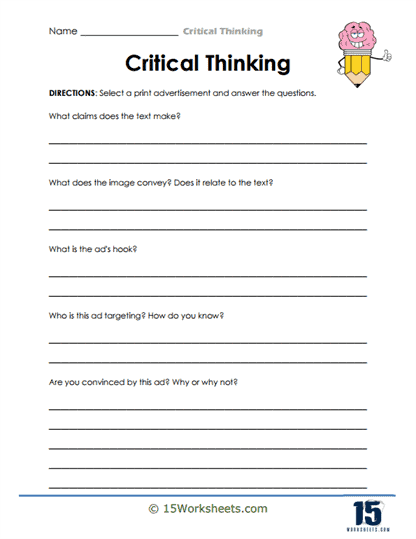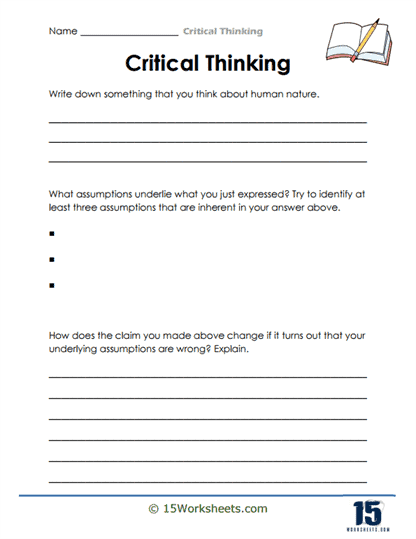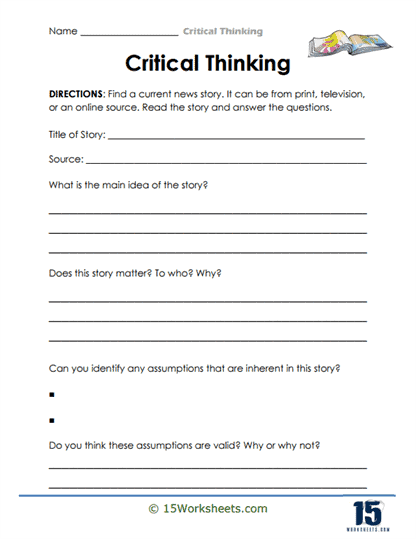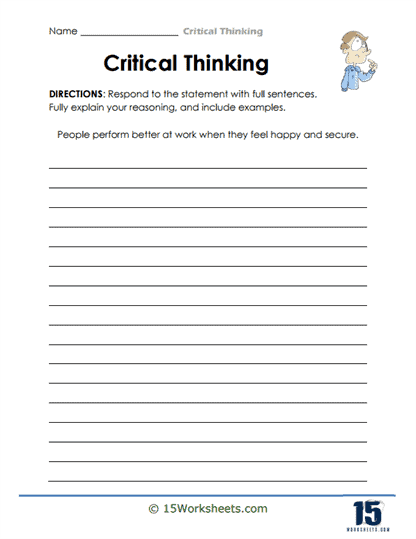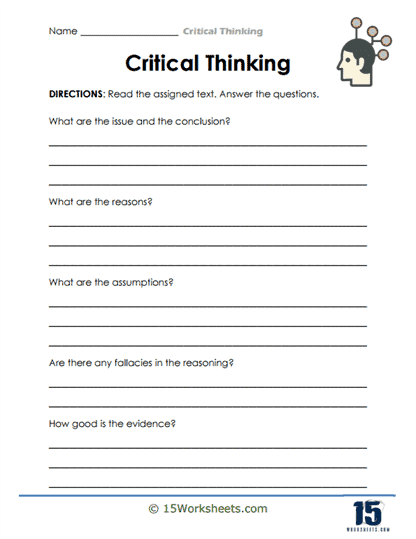Critical Thinking Worksheets
About These 15 Worksheets
Critical thinking is one of the most essential skills a person can develop. At its core, it involves the ability to analyze, evaluate, and synthesize information in a way that goes beyond surface-level understanding. It’s about engaging deeply with ideas, weighing evidence, and considering multiple perspectives before forming conclusions. In a world that is constantly bombarding us with information, critical thinking acts as a compass, guiding us through the complexities of knowledge and helping us make well-informed decisions in every aspect of life.
The purpose of critical thinking worksheets is to serve as a practical tool to sharpen this vital skill. These worksheets are more than just sheets of paper filled with activities-they are structured exercises that challenge your mind to think more deeply. Through engaging prompts, questions, and scenarios, learners are encouraged to dive into higher-order thinking. The goal is not just to find answers, but to explore the process of how those answers are reached, and to develop a strong sense of reasoning. Whether you’re solving a problem, analyzing an argument, or making a decision, critical thinking worksheets provide a framework to think systematically and thoughtfully.
Imagine these worksheets as tools for your brain, much like how weights are used to build physical strength. They force you to push your mental limits, exploring various ways of thinking and finding solutions to complex challenges. Just as you might approach a puzzle, critical thinking exercises invite you to consider different angles, ask probing questions, and seek out the best possible answers. This deliberate practice strengthens your cognitive abilities over time, making you more adept at navigating difficult questions and scenarios, both in the classroom and beyond.
When you train your brain to think in new and different ways, something extraordinary happens-learning becomes more dynamic and engaging. Instead of memorizing facts or relying on rote answers, you begin to connect ideas across subjects. You start noticing patterns and relationships between concepts that previously seemed unrelated. For instance, a lesson in science might suddenly shed light on a historical event, or a math problem could lead to a deeper understanding of a concept in economics. Critical thinking turns the learning experience into a rich web of interconnected ideas, where every piece of knowledge you gain adds depth to your overall understanding.
This transformation in thinking is akin to becoming a detective. Like a detective solving a mystery, critical thinking encourages you to gather evidence, evaluate it carefully, and draw conclusions based on sound reasoning. You develop a mindset that is curious, inquisitive, and always searching for the next clue. Instead of passively accepting information, you actively question it. Why does this fact matter? How does this concept relate to what I already know? What are the possible implications of this argument? These are the kinds of questions critical thinkers ask themselves regularly.
In fact, one of the most powerful benefits of critical thinking is that it helps you become a more independent thinker. Rather than relying on others to tell you what to think, you learn to trust your own reasoning abilities. You develop confidence in your ability to assess situations and make decisions based on logic and evidence. This skill is invaluable not only in academic settings but also in everyday life. Whether you’re deciding what career path to pursue, evaluating the credibility of news sources, or resolving personal conflicts, critical thinking empowers you to approach these situations with clarity and purpose.
Types of Exercises
Comparing and Contrasting
These exercises will have you look at two things and find out how they’re the same or different. For example, you might get pictures of a cat and a dog. You’ll write down how they are alike (like both have tails) and how they’re different (like dogs usually bark, and cats meow).
Cause and Effect
These activities make you think about what might happen because of something else. Imagine if you saw a picture of a melted ice cream cone on the sidewalk. The worksheet might ask, “Why did the ice cream melt?” You’d think about the reasons, like maybe it was a hot day.
Sequencing
These exercises will ask you to put things in order. Let’s say you get pictures showing a seed, a young plant, and a big tree. Your job would be to put them in the right order, from the seed growing up to the tree.
Predictions
With these, you’ll guess what might happen next. Maybe there’s a story about a boy who’s holding an umbrella while looking at dark clouds. The worksheet might ask, “What will he do next?” And you’d guess, “He’ll open the umbrella because it might rain.”
Problem and Solution
Here, you’ll read about a problem and think of ways to solve it. Like, if there’s a story about a girl who keeps losing her pencils, you might suggest she gets a pencil case.
Riddles
Riddles are fun questions or puzzles that make you think hard. An example of a riddle is, “What comes down but never goes up?” The answer? Rain!
Grouping and Categorizing
In these activities, you’ll put things into groups based on how they’re alike. For example, you might get pictures of a car, a bicycle, a fish, and a boat. You’d group the car and bicycle together because they’re ways to travel on land. The fish and boat can be grouped as things related to water.
Making Connections
This helps you link what you already know to new things. If you read a story about a girl who’s sad because her balloon flew away, you might remember a time you felt sad and understand how she feels.
Ask Questions
Some worksheets will have a story or picture, and then you’ll come up with questions about it. Like, if there’s a picture of a forest, you might ask, “What animals live there?” or “Why are forests important?”
How to Help Foster Student Critical Thinking Skills
Improving critical thinking skills in students is a fundamental role of educators, as these skills equip students to analyze, evaluate, and synthesize information in a reasoned manner. To begin with, teachers should cultivate a classroom environment that values questions over answers.
Encouraging students to ask “why” and “how” helps them delve deeper into topics and challenges their preconceived beliefs. Incorporating problem-based learning into the curriculum is another effective approach. By presenting students with real-world problems, they learn to apply their knowledge, analyze situations, and come up with solutions.
Regularly engaging students in debates or discussions on diverse topics can also sharpen their ability to think on their feet, consider different viewpoints, and defend their perspectives with evidence. Furthermore, teachers should emphasize the importance of reflection. After tasks or discussions, providing opportunities for students to reflect on their thinking process can foster self-awareness of their cognitive habits.
Assigning projects that require evaluating information from various sources also helps. In a digital age where misinformation is rampant, teaching students to discern credible from non-credible sources is crucial.
Promoting metacognition-thinking about one’s thinking—can be transformative. By making students conscious of their thought processes and guiding them in recognizing biases, assumptions, or logical fallacies, educators empower them to become more discerning and independent thinkers. In essence, fostering critical thinking is about providing students with tools to think clearly and rationally, equipping them for challenges both inside and outside the classroom.









